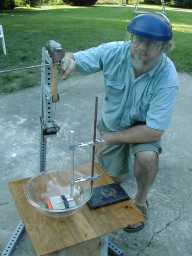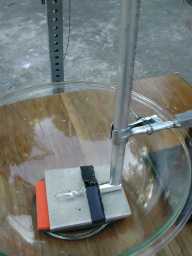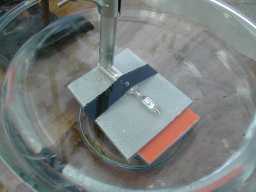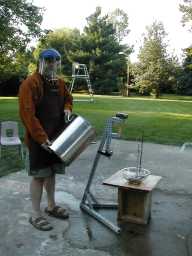Alkali Metal BangsSo far as I am aware, history does not record whether the great chemist Sir Humphrey Davy, who discovered sodium in 1807 by electrolysis of molten sodium hydroxide, ever threw any in a lake. But I think it's safe to say that very few chemists since then haven't.The entire left-most column of the periodic table (not counting hydrogen) is composed of elements that are great fun to throw in a lake, provided of course that you take full account of the speed and effectiveness which which these elements and their caustic oxides can burn your eyes out (permanent blindness is a common side effect of such experiments gone wrong). I have assembled this page to try to shed some light on the truth behind a recent controversy generated by the popular British television show Brainiac. A few seasons ago Brainiac broadcast an episode in which they claimed to show what happens when approximately two grams of each of the five alkali metals (lithium, sodium, potassium, rubidium, and cesium) are thrown into a tub of water. The first three were, probably, real, but the last two explosions turned out to have been completely fake. They simply put a bomb in a bathtub and blew it to bits, pretending that this was the result of two grams of rubidium. Then they did it again and pretended it was two grams of cesium. (Cesium is spelled caesium where they come from, but lying is lying on either side of the Atlantic.) This shocking fact was revealed by reporter Ben Goldacre in an article in The Guardian (a respected daily newspaper in England). The next week he followed up with further revelations about the deplorable state of honesty at Brainiac. (Modesty prevents me from pointing out that his second article compares my humble sodium party most favorably to the fakers over at Brainiac.) And then the following week (July 29, 2006), displaying admirable tenacity, he wrote about it again in an article that links to this very page as a reference to show what really happens. Watch the Brainiac clip for yourself on Google Video, or YouTube. And remember while you're watching it that the whole thing is fake. All that drama and puffing up of the dangers of two grams of rubidium and cesium is just for show. They didn't actually do it. As someone who has personally exploded not two but five grams of rubidium and cesium under water, I thought I should set the record straight. Yes, rubidium and cesium are very reactive. When my British film producer friend Max Whitby and I set out to film a series of alkali metal explosions, we took every possible precaution. I built an ampule smashing machine that allowed us to break open sealed glass ampules from a comfortable distance. In this picture it's set up to smash them underwater (click any picture to get a larger version in a new window):  It has an aluminum rod loosely clamped above the ampule, which is taped to a heavy metal plate (pure nickel, since I'm an element collector and have that kind of thing lying around): 
 Above the rod is a four pound sledge hammer held back by a pin, onto which is tied a long string. The very, very last step is to fill the bowl with warm water:  (Note that in the first picture I just have a face shield, while in this one I have heavy leather protective clothing: The addition of water to the setup greatly increases the potential consequences of a mishap. Note also that my feet are completely unprotected. This is a bit harder to explain.) The machine can also smash ampules above the water and drop the contents down, to more accurately simulate the process of throwing something into a lake. (If you're not familiar with what alkali metal ampules look like, this clip shows me removing a 5 gram rubidium ampule from the ammunition box we kept our stock in.) Enough talk, on to the videos. First we filmed a series of videos smashing the ampules above water: LithiumAs you can see, the rubidium and cesium explosions are, frankly, rather pathetic. We were very disappointed, and began to doubt our own ability to create proper explosions. One idea was that perhaps the rubidium and cesium were in fact so reactive that they blew themselves off the surface of the water before most of the material could react. In this clip I explain this theory, which was supported by the fact that we often found exciting little bits of explosive material on the surrounding concrete (which we rendered safe by use of a large squirt gun). To solve this incomplete reaction problem, we modified the ampule smasher to break the ampules open entirely underwater, and re-filmed the rubidium and cesium explosions: Rubidium UnderwaterRubidium did a reasonable job (although the bowl was not shattered as we had hoped), but cesium again disappoints. What's going on here? Are rubidium and cesium really not that reactive after all? Were the consulting chemists (assuming they had any) just playing a joke on the Brainiac team to see if they could get them to fake some explosions? The answer is that reactivity, as the term is used by chemists, does not accurately correlate with the size and spectacle of the resulting explosion. When an alkali metal is dropped into water, there are two separate stages to the explosion. First, the metal reacts with the water, tearing off and liberating hydrogen gas. Second, and this part doesn't always happen, the heat generated by the first part of the reaction ignites the hydrogen gas, which burns, sometimes explosively, in the surrounding air. It is this secondary hydrogen gas explosion that produces the visible flame above the bowl of water and/or lake, not the initial reaction of the metal with water (which, of course, tends to happen mostly under water). And it doesn't matter which alkali metal created that hydrogen gas: Hydrogen is hydrogen, regardless of its source. All that matters is how much of it there is when it's lit, and how well it's mixed with air before it's ignited. Generally speaking, the hydrogen gas explosion contributes more to the overall visible size of the explosion than does the initial metal-water reaction. And this brings into play an important fact: When you go down the periodic table from lithium to cesium, the atomic weight goes up from 6.94 to 132.9. Higher atomic weight means fewer atoms per unit of weight, and the amount of hydrogen gas generated is directly proportional to the number of atoms. So 5 grams of cesium liberates only about one twentieth as much hydrogen as five grams of lithium, and a bit over one sixth as much as 5 grams of sodium. You might think this would mean lithium gives the biggest hydrogen explosion, but as you can see from the video it reacts so gently that it never gets hot enough to actually set off the hydrogen. And if it did, it's producing gas so slowly that very little would still be close enough to be ignited. Sodium and potassium are the happy medium: They produce lots of hydrogen gas, and they do it fast enough that it is still around when they get hot enough to ignite it. In fact, sodium often waits just about exactly the right amount of time to allow a large plume of hydrogen to accumulate and mix with oxygen from the air before igniting an almighty bang. In a very real sense the slightly lower rate of reaction of sodium compared to potassium makes it a perfect time fuse, an essential component in any fuel-air bomb. With potassium you tend to get very energetic, but basically small-scale explosions of gas: It reacts and heats up so rapidly that the gas is ignited before much has accumulated. Sometimes more or less the same thing happens with sodium (for example, if a small piece breaks off and heats up rapidly, it might ignite the gas sooner than normal). But other times the sodium sits there hissing and sizzling without a flame for what seems like an eternity (but is actually at most maybe 5 seconds). That's when I start to cringe, because I know that all that time it's building up an invisible plume of hydrogen-air mixture which, sooner or later, is going to make a really loud bang. This unpredictability makes sodium arguably the most dangerous of the alkali metals in inexperienced hands (soon to be inexperienced stumps). The behavior of large pieces is very different from that of small pieces, and on my sodium party page you can read numerous stories contributed by people who have experienced first hand the unpredictable nature of this beast. Including some who have had their eyes permanently damaged by it. Given half a chance it will take your sight from you: Do not give it that chance. That means wearing eye protection at all times when handling sodium or any alkali metal. You remember the picture above where my feet are bare? That's basically a risk I'm willing to take. I wouldn't particularly enjoy having cesium splashed on my feet: Depending on the quantity I would experience burns up to a fairly serious level. By serious I mean going to the hospital for a skin transplant, weeks of physical therapy and living with pain for months thereafter. But given the level of precautions we took, and the severity of that possible consequence, I chose not to wear long pants on a hot day. You will never see me without glasses, or more likely a full face shield, anywhere near any remotely energetic chemical reaction. Loosing your eyesight simply does not compare with any other injury I can imagine suffering. All four limbs chopped off? Not even close. Now back to alkali metals. If you are interested in further reading, my Periodic Table Table website has lots more stuff like this, including photographs and descriptions of over a thousand samples of the chemical elements. These are the entries for the five alkali metals: LithiumIf you just want to see my stock photography library for each element, these links show the pictures in more compact form (same pictures just without the descriptive text): LithiumIf you're into elements, you should have some! My site has a lot of information about where to get samples, or you can order complete sets and wall displays from my partners at RBG Research, which sells the finest sets in the world. If you want something to hang on the wall, get my photographic periodic table poster! It's quite pretty. |
| (Just a quick note about the google ads you see above. These are placed automatically by google, and I do not necessarily endorse any of the products advertised. In particular, any page that mentions the word "cesium" is sure to attract ads promoting cesium chloride as a cure for cancer. This is complete bunk, vile worthless quackery of the worst kind.) |